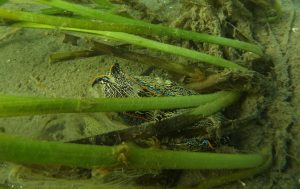Coastal managers chart path forward for promoting optimized restoration and assessment of eelgrass beds

The eelgrass habitat suitability model – described in a SCCWRP technical report published in July – will consist of a mechanistic model for predicting eelgrass growth along Southern California’s coast. Eelgrass beds provide essential habitat for endangered or threatened species, can buffer against the ecological effects of localized ocean acidification, and have the potential to serve as a carbon sink.
In recent years, estuary managers across Southern California have invested significant resources to restore and maintain eelgrass beds in accordance with California’s Eelgrass Mitigation Policy. However, managers have relied on incomplete historical data and best professional judgment to inform their decision-making about protection and restoration, leading to mixed success with eelgrass sustainability.
SCCWRP brought together water-quality regulators, federal agencies, academic researchers and others to work toward consensus on what is needed to optimize restoration and protection of eelgrass beds in Southern California. The group evaluated the latest literature, local historical data and a variety of existing eelgrass bed models to assess eelgrass bed state of the science and management options.
The outcome was identifying the most important data gaps and how to fill them, plus acknowledging that the new eelgrass suitability model is necessary for successful Southern California decision-making.
The eelgrass habitat suitability model that the group agreed to develop will enable Southern California managers to predict how much eelgrass should be growing at a given site in the present day, under conditions of minimal disturbance from human activities. The model also will be able to make this prediction after taking into consideration future projections about sea level rise and water temperature changes at the site.
Furthermore, the model’s ability to predict reference condition – what the site would look like in the absence of human activities – will provide critical context as coastal managers work to understand a site’s potential to sustain eelgrass beds over the long term, even in the face of climate change.
Eelgrass beds, which are submerged meadows of aquatic flowering plants that grow only in shallow coastal waters, are sensitive to even small changes in water quality and water turbidity, which can reduce sunlight. Much of the eelgrass beds that historically dotted the Southern California coastline have been decimated by human development.
Under California’s Eelgrass Mitigation Policy, coastal managers are often required to offset the impacts of coastal development and similar human activities by restoring eelgrass beds and/or taking mitigation measures to protect these habitats. Successful planting efforts in Southern California include Mission Bay and Upper Newport Bay, where much of the existing eelgrass monitoring data has been generated.
However, significant data gaps remain, particularly in Southern California’s many smaller embayments and coastal ecosystems.
Although modeling tools have been developed to inform where eelgrass beds are likely to survive under present-day conditions, these relatively simple tools do not generate insights about reference conditions for an eelgrass bed, nor do they provide insight into how climate change will alter where eelgrass beds can survive over the long term.
With the appropriate data, a predictive eelgrass habitat suitability model for Southern California could be built in three to five years.
The modeling tool will complement other tools that SCCWRP and its partners have already developed or are working on to support eelgrass management efforts in Southern California. The tools are organized into a three-tiered framework for assessing eelgrass health, and include development of mapping tools for estimating historical extent of eelgrass beds, a method for rapidly screening eelgrass beds to assess their overall health, and a more involved assessment method that evaluates ecological functioning.
For more information, contact Dr. David Gillett.
More news related to: Bioassessment, Regional Monitoring, Top News